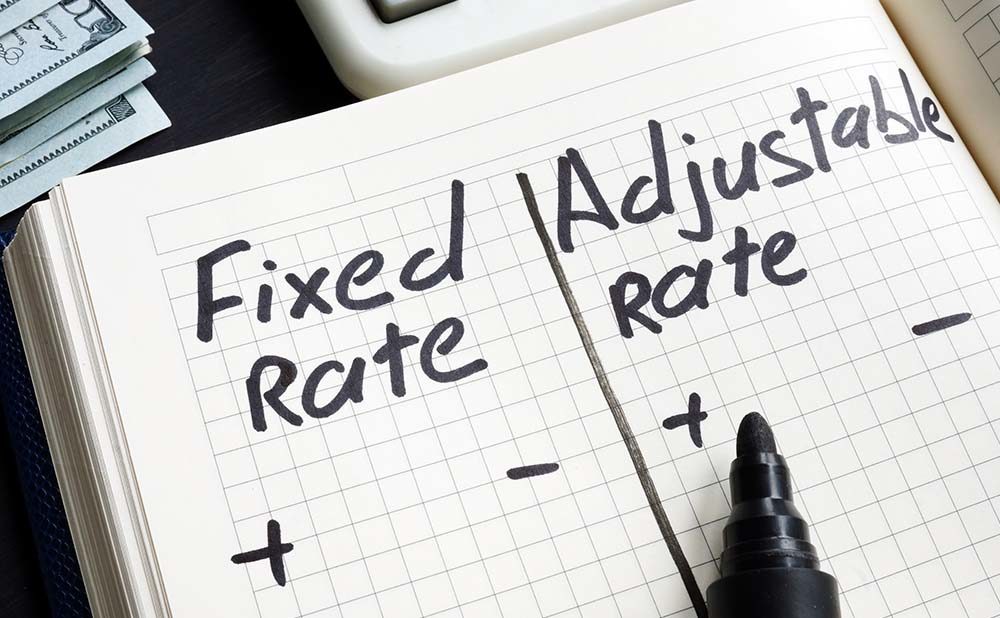
What is a Fixed-Rate Mortgage?
Home buyers who get a fixed-rate mortgage receive a home loan in which the interest rate remains the same through the full term of the loan, most commonly for 30 years, but terms can vary. Monthly payments with a fixed-rate mortgage never change — unless taxes or insurance rates in escrow increase or decrease on your home. The principal and interest rates stay the same.
When you take out a fixed-rate mortgage on a home, you’ll get an amortization schedule from your lender. This schedule outlines exactly the number of payments you’ll need to make, and at what amount, as well as the balance remaining on your loan after each payment. You’ll be able to look to the amortization schedule to determine how much you’ll spend in interest throughout the life of your loan.
What is an ARM Loan?
Home-buyers with an adjustable-rate mortgage can expect the interest rate to fluctuate over the years. The mortgage ties the interest rate to a margin that includes a stated index, such as the Libor or Treasury bill yield, and a spread. The index can change, but the spread always remains the same. An ARM loan adjusts based on the mortgage terms, so if interest rates increase, so, too, will your monthly payment.
What if Interest Rates Change?
With a fixed-rate mortgage, if interest rates drop, you must refinance your home to get the benefit of the lower rate. To refinance, you will need to contact your mortgage lender to discuss options. You may need to pay for a new loan origination fee, among other things, to complete a refinance.
With an ARM loan, your interest rate changes every year. You do not have control over your interest rate with this type of loan. However, because you could end up with a very low interest rate for certain years, your monthly payment could be reduced throughout your loan term. Conversely, if interest rates drastically increase, your monthly payments will increase. You do not need to refinance for your interest rate to change.
What are the Types of ARM Loans?
Depending on the ARM loan you choose, your interest rate will remain fixed for a period of years before changing every year on the anniversary of the mortgage, for the remainder of your loan term. In this way, an ARM is a hybrid loan, because homebuyers do get a fixed interest rate for a certain number of years.
A 3/1 ARM, also known as a 3-year ARM, is a loan with a fixed interest rate for the first three years, but the rate changes once per year for the remaining term of the mortgage.
Similarly, a homeowner with a 5/1 ARM loan will enjoy five years of a fixed-rate mortgage, with the interest rate changing once per year. A 7/1 ARM loan and a 10/1 ARM loan work similarly, in that the first number in their name is the length of time in years with a fixed interest rate.
Case Study
To better understand how a fixed-rate mortgage and an ARM loan differ, let’s take a look at two loans: a 30-year fixed-rate mortgage, and a 5/1 ARM.
For simplicity’s sake, let’s say you’re purchasing a home for $100,000. You have a $20,000 down payment, and a 30-year fixed-rate mortgage with a 5 percent interest rate. Your homeowner’s insurance is $1,000 per year, and your annual property tax is 1 percent.
With this fixed-rate loan, you’ll have an $80,000 loan balance and will make monthly mortgage payments of $649 per month for 30 years. In the first five years, you’ll have paid $19,230 in interest and $6,537 toward the principal of the loan. In year 30, you’ll have paid your entire principal – $80,000 – and a total of $74,468 in interest.
Comparatively, with a 5/1 ARM loan with the same loan balance, property tax, starting interest rate, and homeowners insurance, you’ll start out with a $596 monthly payment, a monthly savings of $53 per month. In the first five years, you’ll have paid the same amount in principal and interest as you would with a 30-year fixed. However, by year 30, you are projected to have paid $142,198 in interest. Of course, this can vary depending on what the interest rates are each year of your loan term.
When Should I Choose an ARM Over a Fixed-Rate Mortgage?
Based on the case studies, it seems like an ARM loan doesn’t save you money in the long-term because of interest rates. However, there are compelling reasons to choose an ARM.
- You may qualify for a lower interest rate on an ARM loan than a fixed-rate loan, depending on the current financial climate. Some lenders charge more interest on a fixed-rate loan than an ARM loan.
- The savings in the mortgage payments in the first few years of the loan gives homebuyers extra money to invest elsewhere.
- ARM loans can be a cheaper way for borrowers to finance a home, especially if they don’t plan to live there for very long.
Choose Homestead Financial for Your Mortgage
Homestead Financial serves homebuyers in the Kansas City, MO and St. Louis, MO metropolitan areas, including Godfrey, IL and Glen Carbon, IL, and Overland Park, KS. We’re the “gold standard” in mortgages for every property type, and are ready to take care of every step of the home loan process for you.